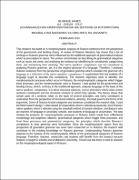Uchanganuzi wa kimofosintaksia wa sentensi za kitooro kwa Mkabala wa Nadharia ya Umilikifu na Unganifu t.
Abstract
ABSTRACT
This research has dwelt on A morphosyntactic analysis of Rutooro sentences from the perspective of the government and binding theory. A review of Rutooro literature has shown that a lot of writings on Rutooro grammar were influenced by the traditional approach of grammatical analysis which is prescriptive in nature. The writers concentrated on describing the grammatical categories such as nouns and verbs, and analysing the sentence by identifying its constituents, categorizing them, and interpreting their meaning. The native speakers’ competence was not considered in analysing Rutooro grammar, yet, it is the original grammar of a language. Therefore, I analysed Rutooro sentences from the perspective of generative grammar which considers the grammar of a language as a reflection of the native speakers’ competence. It empharsises that any analysis of a language ought to describe this competence. The research objectives were to identify: the morphosyntactic processes which occur in Rutooro; the morphosyntactic categories which trigger these processes; and the morphosyntactic rules in Rutooro. I was guided by the government and binding theory, which, contrary to the traditional approach, analyses language on the basis of the native speakers’ competence. It is about structural relations: it gives principles which relate certain sentence constituents and the structural contexts in which they operate. The theory shows that certain parts of a sentence relate on the basis of several principles, and every constituent is understood from the perspective of structural relations, whereby, the head governs the forms of its arguments. Some of Rutooro lexical categories and sentences constituted the research data. I used the field research design: I interviewed 30 respondents whom I selected purposively: local Rutooro native speakers whom I selected using the snowball method of sample selection; and Batooro who are teachers of language in secondary schools, and students of language in universities. The data showed the presence of: morphosyntactic processes in Rutooro which result from inflectional morphology and anaphoric relations; grammatical categories which trigger these processes, and from these processes and grammatical categories, the principles which describe Batooro’s competence in their grammar were formulated. Since the morphosyntactic aspect from the perspective of generative grammar has never been researched on in Rutooro, the research will contribute to the existing knowledge on Rutooro grammar. Understanding Rutooro grammar depends on the mastery of the morphosyntactic effects of the grammatical categories of Rutooro language. Therefore, teachers, researchers and students will benefit from the research because Rutooro is taught in schools and at Makerere University. I found out that there is need to research

